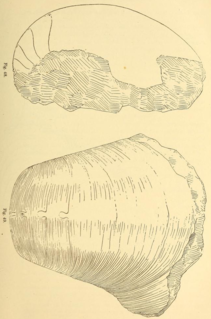
Anapachydiscus is an extinct cephalopod genus from the Upper Cretaceous, Santonian - Maastrichtian of Europe, Africa, Madagascar, S.India, N Z, Calif. Mexico, Argentina, and the Antarctic belonging to the ammonoid family Pachydiscidae.
Permonautilus is an extinct genus of nautilids from the Upper Permian of Russia, named and described by Kruglov in 1933. Permonautilus is an involute, globular, spinose member of the Lirocertidae which are included in the Clydonautilaceae. Whorl sections are broad, with a rounded venter. The umbilicus in the middle of the shell is deep, from which spine-like processes extend laterally in the mature portion near the aperture. The siphuncle in Permonautilus is subcentral, the suture, slightly sinuous.
Syringonautilidae is a family of Nautiloidea from the middle to late Triassic. Syringonautilidae comprise the last of the Trigonoceratoidea and are the source for the Nautilaceae which continued the Nautiloidea through the Mesozoic and into the Cenozoic right down to the recent. Syringonautilidae is a strictly Triassic family, derived early in the Triassic from the Grypoceratidae.
The Centroceratidae is the ancestral family of the Trigonoceratoidea and of the equivalent Centroceratina; extinct shelled cephalopods belonging to the order Nautilida
Aphelaeceras is an extinct genus from the nautilid family Trigonoceratidae which is part of the Trigonocerataceae, that lived during the Mississippian Period in the late Paleozoic.
Condraoceras is a genus of liroceratids from the Pennsylvanian of North America and Lower Permian of Europe with a compressed, involute, nautiliconic shell; subcircular whorl section; small umbilicus with a rounded shoulder; suture with shallow ventral and lateral lobes; and narrow subcentral siphuncle.
Peripetoceras is a genus in the Clydonautilacean family, Liroceratidae. It can be recognized by its smooth, involute shell with a deep small umbilicus with rounded shoulders and steep convex wall; whorl section with flattened venter, rounded ventral shoulders and convergent slightly convex flanks; suture with slight ventral and lateral lobes; and small siphuncle located dorsally of the center.
Bistrialites is an involute, globose Clydonautilacean belonging to the Liroceratidae with a reniform whorl section, large funnel shaped umbilicus, smooth surface except for spiral ornament in the region of the umbilical shoulder. Bistrialites comes from the Lower Carboniferous (Mississippian) of Europe.
Ephippioceratidae is a family of clydonatilacean nautilids with shells as in the Liroceratidae but with sutures that have deep ventral and dorsal saddles. This group, which contains two genera, Ephippioceras and Megaglossoceras, has a range from the Mississippian to the Lower Permian.

Macrocephalites is a genus of the stephanoceratoid ammonite family Macrocephalitidae, diagnostic of the Callovian stage of the Middle Jurassic. Three subgenera, Dolikephalites, Kamptokephalites, and Pleurocephalites are recognized in addition to Macrocephalites itself, with Indocephalites tentatively included as the fourth.
Enoploceras is a Tainoceratid genus, a nautiloid cephalopod in the order Nautilida, known from Triassic sediments in Europe, India, Timor, and the state of Idaho.
Encoiloceras is a genus of Tainoceratids, a nautiloid cephalopod in the order Nautilida that has been found in Upper Triassic (Carnian) sediments in the Alps and Hungary.

Eutrephoceras is an extinct genus of nautilus from the Late Jurassic to the Miocene. They are characterized by a highly rounded involute shell with slightly sinuous suture patterns.
Indonautilus is an involute nautilid from the Middle and Upper Triassic. (Anisian-Norian), with a small or occluded umbilicus and subrectangular whorl section belonging to the Liroceratidae (Clydonaulilaceae). Flanks are slightly bowed, converging on a flattened venter. Ventro-lateral shoulders are narrowly rounded or angular. Umbilical shoulder are broadly rounded. The siphuncle is subdorsal.

Asymptoceras is a genus of aipoceratids (Nautiloidea) similar to Aipoceras but tightly coiled and with only part of the body chamber divergent from the previous whorl. Shell evolute, expanding fairly rapidly; umbilicus open, perforate; whorl section ovoid to subquadrate.

Cleviceras is an extinct genus of cephalopod belonging to the family Hildoceratidae. These cephalopods existed in the Jurassic period, during Toarcian and possibly even uppermost Pliensbachian age. Sometimes, it is considered to be a synonym of Eleganticeras.
Paracymbites is an extinct genus of lower Jurassic ammonite that lived during Raricostatum zone of upper Sinemurian. Animals belonging to this genus had small shells with semicircular whorl section and rounded or fastigate venter, of which umbilicus made about 25% of diameter. Last whorl could have been excentric. Keel was faint and it might have been only on the earlier part of the last whorl. Aperture had ventral rostrum. Body chamber made about 75% of whorl and was faintly plicate, or smooth.
Porpoceras is genus of ammonite that lived during the early and middle Toarcian stage of early Jurassic. Members of this genus existed from uppermost part of the Harpoceras serpentinum zone to the Haugia variabilis zone. Their fossils were found in Europe, Asia, North America and South America.
Transicoeloceras, which is sometimes considered to be a synonym of Catacoeloceras is genus of ammonite that lived during Toarcian stage of early Jurassic. Their fossils were found in Hungary, Italy, France, southern Spain and South America. It has evolved from Mesodactylites.
Telodactylites, which is sometimes considered to be a synonym of Porpoceras is genus of ammonite that lived during Toarcian stage of early Jurassic. Their fossils were found in Europe, northern Africa and South America. It has probably evolved from Mesodactylites.




